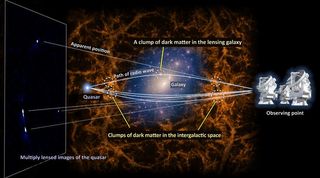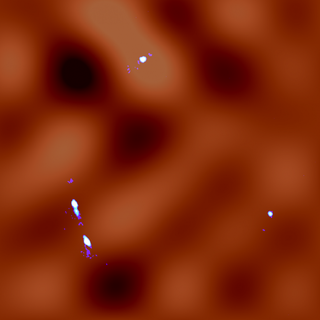Dark matter 'clumps' found by tapping into Einstein's general relativity theory
Observing a distant quasar powered by a supermassive black hole could help better constrain the properties of this mysterious form of matter.

Astronomers have used a principle first proposed by Albert Einstein over 100 years ago to map the distribution of dark matter in unprecedented detail. The team's method managed to reveal the presence of dark matter "clumps" between galaxies, showing how this mysterious substance is distributed on smaller scales.
Fluctuations in the observed dark matter, identified between a distant quasar (or bright light source powered by a feeding supermassive black hole) and a galaxy between that quasar and Earth could help constrain the properties of the elusive substance.
Dark matter is troubling for scientists because, despite the fact it makes up about 85% of our universe, it is effectively invisible. This is because dark matter either doesn't interact with any electromagnetic radiation, including visible light, or does so incredibly weakly.
This means the particles that make up dark matter — whatever they are — cannot be atoms comprised of electrons, protons and neutrons. These are the baryons that form everyday matter that makes up stars, planets, our bodies and everything we see around us on a day-to-day basis.
It is this puzzle that has prompted an intense search for these so-called dark matter particles.
Related: We still don't know what dark matter is, but here's what it's not
Thus far, the only way scientists can infer the presence of dark matter is by looking at the effect it has on "normal" matter via gravity. Indeed, when astronomers do this, they have found that if galaxies weren't mostly made up of dark matter, their contents would quickly fly apart as they are rotating too rapidly to be held together by the gravity of the visible matter within them.
Get the Space.com Newsletter
Breaking space news, the latest updates on rocket launches, skywatching events and more!
Not only are galaxies believed to be enveloped by halos of dark matter to prevent such a catastrophe, but some dark matter models also suggest there should be clumps of dark matter inside galaxies as well as filling the space between them.
A team of researchers from Japan, led by Kindai University's Kalki Taro Inoue, set out to use the Atacama Large Millimeter/submillimeter Array (ALMA) to better understand the distribution of dark matter around a distant, massive galaxy and find clumps of the mysterious matter in intergalactic space.
To do this, they observed light from a quasar called MG J0414+0534, located 11 billion light-years away from Earth, by using an effect called gravitational lensing.
Putting dark matter under a cosmic magnifying glass
Gravitational lensing is a concept that first emerged from Einstein's theory of gravity, general relativity, which was published in 1915. This concept differed radically from Newton's theory of gravity because it reimagined the fabric of space and time — united as 4-dimensional spacetime — as a dynamic element of the universe, not just a static stage upon which cosmic events play out.
Einstein envisioned objects of mass as causing a curvature or "warp" in the fabric of spacetime. The greater the mass, the more extreme the curvature in spacetime. This can be pictured as a simple 2D case of objects being placed on a stretched rubber sheet. A bowling ball will create a larger dent in the sheet than a tennis ball, just as a galaxy creates a larger curve in spacetime than a star.
Moreover, something really cool happens when a massive object of great mass comes between Earth and a distant source of light like another galaxy, a star, or in this case, a quasar. Light would usually travel in a straight line to Earth, but when it passes this curvature in space, its path gets curved, too. Masses closer to our planet that cause such curvature lead to more extreme deflections.
This means light from a single source can take different paths around a massive object and can thus arrive at a telescope at different times. This can cause a single object to be brightened and amplified in an image or even appear at multiple places in the same image.
The intervening object is, therefore, referred to as a gravitational lens.
Gravitational lensing can help scientists see objects that would usually be far too distant and faint to observe. For example, the James Webb Space Telescope (JWST) has been using gravitational lensing to great effect to see galaxies in the early universe.
But beyond to helping scientists study the subject of gravitational lensing, the effect can also be used to map the distribution of matter in a galaxy acting as the cosmic lens in the first place. That includes mapping dark matter.
Thus, astronomers have been able to map the distribution of visible matter, then infer the distribution of dark matter in lensing galaxies.

Inoue and the team did this for dark matter in the galaxy lensing their distant quasar subject, causing MG J0414+0534 to appear four times in a single ALMA observation. This allowed the researchers to capture the galaxy with a higher resolution than ever before, and map its dark matter down to a scale of 30,000 light-years.
They were also able to take the application of gravitational lensing a step further.
With the high resolution of ALMA, the astronomers were able to map the distribution of dark matter clumps that lie between galaxies and along the line of sight to the quasar 11 billion light-years away. The results delivered by the researchers help to confirm the so-called "cold dark matter" (CDM) model of the universe, which suggests dark matter is made up of slow-moving particles.
That is because the CDM dark matter model predicts clumps of dark matter should exist both inside galaxies and outside them, distributed through intergalactic space.
The team's research was published on Thursday (Sept. 7) in The Astrophysical Journal.
Join our Space Forums to keep talking space on the latest missions, night sky and more! And if you have a news tip, correction or comment, let us know at: community@space.com.

Robert Lea is a science journalist in the U.K. whose articles have been published in Physics World, New Scientist, Astronomy Magazine, All About Space, Newsweek and ZME Science. He also writes about science communication for Elsevier and the European Journal of Physics. Rob holds a bachelor of science degree in physics and astronomy from the U.K.’s Open University. Follow him on Twitter @sciencef1rst.
-
Questioner "...the only way scientists can infer the presence of dark matter is by looking at the effect it has on "normal" matter via gravity."Reply
What is seen is gravitational effects ONLY.
Relativity does NOT require matter to create/cause gravity/curvature.
Hypothesizing some form of matter confabulates something with absurd, impossible properties far beyond mere invisibility.
'Dark matter' is provably wrong.
https://forums.space.com/threads/dark-matter-is-provably-wrong.62921/ -
Tom Petek I've written a paper that claims to show that dark energy is a characteristic of hydrogen. The same paper presents implications that dark matter is also diffuse hydrogen "clumping" due to the sixth-order nature of its intrinsic self repulsion balancing against gravity.Reply
Still looking for an informed detailed opinion on that paper:
https://www.academia.edu/106245152/230826_Dark_Energy_Intrinsic_to_Atomic_Hydrogen_pdf -
Torbjorn Larsson Reply
The article rejects your unquantified claim. The paper states clearly that it has successfully tested the CDM prediction of the LCDM theory, i.e. that dark matter not only exists but is as massive (slow moving, "cold") as the theory says.Questioner said:'Dark matter' is provably wrong. -
Torbjorn Larsson Reply
That text is not a peer reviewed paper so I doubt people interested in science would look it up (say, I wouldn't). If you are serious, try to submit it to a peer review journal, then you get the informed detailed feedback you want (and need).Tom Petek said:I've written a paper that claims to show that dark energy is a characteristic of hydrogen. The same paper presents implications that dark matter is also diffuse hydrogen "clumping" due to the sixth-order nature of its intrinsic self repulsion balancing against gravity.
Still looking for an informed detailed opinion on that paper:
https://www.academia.edu/106245152/230826_Dark_Energy_Intrinsic_to_Atomic_Hydrogen_pdf
Meanwhile, some basics: You can't use the same objects to explain the two different space expansion characteristics, or have matter emulate the expansion characteristic of potential energy (such as inflation or dark energy).
See https://en.wikipedia.org/wiki/Scale_factor_(cosmology) for a description of what is observed and what a theory has to explain (and even better than LCDM to replace it). -
Questioner Cold' like the near absolute zero of empty space?Reply
These guys are mapping gravity on a relatively fie scale, P-E-R-I-O-D.
How in any way does that prove any kind of matter is involved at all?
It does not.
De Sitter & Schwarzschild space-times are both examples of relativity consistent space-times devoid of ANY matter yet abundant with gravity/curvature.
I have outlined that the nonsensical 'dark matter' has
self-contradicting responses to gravity.
A self-contradicting property with respect to a FUNDAMENTAL LAW of physics is
ABSURD!
It makes the hypothesis of 'dark matter'
intellectual trash. QED.
Torbjorn Larsson said:The article rejects your unquantified claim. The paper states clearly that it has successfully tested the CDM prediction of the LCDM theory, i.e. that dark matter not only exists but is as massive (slow moving, "cold") as the theory says. -
Tom Petek Reply
Thank you for your feedback.Torbjorn Larsson said:That text is not a peer reviewed paper so I doubt people interested in science would look it up (say, I wouldn't). If you are serious, try to submit it to a peer review journal, then you get the informed detailed feedback you want (and need).
Meanwhile, some basics: You can't use the same objects to explain the two different space expansion characteristics, or have matter emulate the expansion characteristic of potential energy (such as inflation or dark energy).
See https://en.wikipedia.org/wiki/Scale_factor_(cosmology) for a description of what is observed and what a theory has to explain (and even better than LCDM to replace it).
I have submitted various versions of this paper 9 times to 5 different journals. All were rejected. The one line of feedback I got said I needed to provide more proof, - which is odd because I consider the paper a proof.
Four academics I contacted volunteered to do a brief review. General consensus was my paper can’t be right because it looks too classical. Still have no feedback as to what is fundamentally wrong with my approach. Would love to get closure one way or another but still need a competent reviewer with some time to spare.
I believe what I’ve come up with is just part of the explanation for cosmic expansion. The effectively electrostatic repulsion between hydrogen atoms is a potential energy driving expansion. The paper presents a result that is quantitative, arrived at via a few fully explained assumptions and calculations. If anything it is a boring analysis to review. On the other hand the implications could be viewed as outrageous.
Did look at the article on scale factor, and have seen it before. My view is that cosmology is still “the wild west”. Much is still speculative.
Given my situation, how would you suggest I find closure?
